The Clinical Implications of Contact Lens Machinability
BY WILLIAM E. MEYERS, Ph.D.
NOV. 1997
It is generally accepted that properties such as Dk, wetting angle and flexibility are important considerations when choosing an RGP contact lens material. It is less appreciated that other properties that relate to the machinability of a material may have significant clinical implications as well.
For insight on the clinical performance of the next RGP contact lens you prescribe, you may want to take a look at how the material you select behaves throughout the manufacturing process.By assessing power, curvature and clinical performance using small apertures, short chords and high illumination respectively, it's difficult to detect many lens performance qualities that are responsible for differences in crispness of vision or comfort between lenses of purportedly identical design. Historically, there have been no verifiable methods to quantify these "manufacturability" issues. Here, we present reliable criteria that you can consider when choosing the lens material for your patient.
MANUFACTURABILITY CRITERIA
In this study, researchers compared three RGP materials according to the following manufacturability criteria:
- sensitivity to diamond usage (rate of lens surface quality deterioration over the course of diamond life);
- minimal polishing demand (changes in optical quality that occur with different degrees of polishing); and
- base curve stability (amount of change in lens geometry as a function of front curve cutting, processing/hydration cycling and variations in lens thickness).
Using objective as well as subjective measures, we also evaluated surface quality and optical quality of the finished lenses processed by identical methodology under controlled conditions.
Diamond Wear and Quality -- Diamonds for precision lathing are expensive, and today's best lathes require precise diamond geometries. Materials that erode diamonds quickly or are highly sensitive to deteriorating diamond geometry increase product cost or lose surface quality if the worn diamonds are not replaced frequently enough. You may not be able to detect the effects of surface deterioration at this level, but your patients may report reduced crispness of vision or reduced comfort while they still recite the 20/20 line.
Minimal Polishing Demand -- Probably the most deleterious process in contact lens manufacture is polishing. No other step presents a greater opportunity for defects to develop. Most practitioners recognize that over-polishing can cause burned surfaces and power changes, but few practitioners are aware of its effect on optical quality.
Although manufacturers have made heroic attempts to minimize the distortions introduced by polishing (pitch polishing, tumble polishing, etc.), there are simply few effective means to control a process as chaotic as the erosion of a shape by particulate abrasion. Under identical conditions, different materials of otherwise similar characteristics will require different degrees of polishing and will exhibit varying degrees of surface distortion. The best approach is to select a material and manufacturing process that relies as little as possible on polishing.
Geometric Stability -- Predictability of final geometry depends upon a material's contour stability during manufacture. Sometimes material stability reflects the skill of the laboratory. Excessive collet pressure, heat and stress generated by attempting to cut away material too quickly or improper choice or use of cleaning solvents can cause a button to surrender the accurate shape that had been lathed into it. However, residual stress, weak resistance to deformation (related to flexibility), extractable content, thermal expansion coefficient and solvent swellability (related to composition and crosslink density) are all inherent characteristics that together dictate material stability.
Material stability manifests as four important aspects of lens manufacture: firmness during lathing, stability to solvent and hydration cycles, optical quality and predictability of base curve as well as power. Obviously, vision quality and fit can be affected by the manifestations of these material properties during processing. The design of a contact lens (its overall thickness and differential thickness throughout) will also have an impact on the final geometry.
Material Shear Mode -- Similar to diamond wear in its effect on surface quality is the mode by which a material cleaves under the shearing force of the diamond. Whether a material stretches and tears, pulverizes, melts like butter or peels will determine the pattern and contour of lathe marks left behind after cutting. Though lathing conditions may be adjusted to accommodate some of the effects, these adjustments are only compromises, and the material character itself remains an overriding influence on final surface quality. Our objective and subjective evaluations in this study address these surface issues.
STUDY DESIGN
Two of the three materials we compared, Paragon Vision Sciences' FluoroPerm 30 (F-30) and Polymer Technology's Boston ES (B-31), are generally considered workhorses for the industry. The third is a 120 Dk experimental material (EX-120), which has demonstrated difficulty in manufacturing and has never been offered commercially. We used state-of-the-art computer controlled lathes with parts that were prepared by an outside contractor who was unaware of the materials we selected. All experiments were performed with fresh diamonds, and each material was lathed with a diamond exposed to materials of that type only.
A new finishing diamond was installed in an Optoform 50 lathe, programmed to cut a 7.8mm central base curve (peripherally aspheric) with a radial edge lift of about 0.087mm in each lens. For each study material, we cut 108 bases sequentially and evaluated every third one (yielding 36 test bases from each manufacturers' batch). We kept the first 12 bases in each test material (labeled parts 1-12) as base curves only, but sent the remaining 24 bases on for front curve cutting.
But you may ask, "Why does this matter to me? My lab rejects out-of-spec lenses before I get them." The specifications and methods your lab uses to measure materials reflect its expectations of a particular material. Even the ANSI standards, so often quoted, were developed to accommodate the lowest common denominators in material and equipment performance. Correspondingly, the tools we use to check product quality reflect allowances made for material instability. Also, contact lens designs are too tolerant of the effects of material insufficiency. Today's materials, manufacturing equipment, analytical tools and even clinical measurement could, and in increasing numbers do, support higher standards than a few years ago. Of course, we must consider the manufacturing costs and time delays that result when a lab either suffers lower yields on products or starts two lenses in order to assure at least one success within the delivery time it has promised. The benefits to your patient in performance and quality, and to the lab in yield and production time, always offset any increased cost for materials exhibiting superior manufacturability. |
Using a new front surface diamond, parts 13-24 were blocked and received front surface cuts in four nominal powers, +3.00D, -3.00D, -6.00D and -9.00D. We cut powers of -6.00D and -9.00D aggressively thin in center thickness targets of 0.09mm; the rest had standard center thicknesses of 0.22mm and 0.12mm. These were left unpolished on both surfaces.
Parts 25-36 were very briefly polished with a flexible lap for 10 seconds then blocked. We cut front surfaces to the same nominal powers and thicknesses listed above. These front curves were polished for 10 seconds.
Parts 25-36 were also processed in a stability test which exposes the lenses to soaking solution for a defined period of time and then allows them to dehydrate again. We cut three additional parts from each material (parts 37-39) with a roughing diamond as base curves only to explore the relative surface quality of lenses cut with a controllably worn diamond. All lenses were 10.0mm in diameter.
Using five measures of lens quality, we compared the manufactured parts from each material batch. Trained inspectors who were unaware of the material assignments made all subjective measurements. The measures of quality were: surface quality using a Talysurf contact profilometer; qualitative surface appearance; base curve (initial, during and after hydration in solution); qualitative optics; and front curve and power measurement.
BASE CURVE VS. DIAMOND CUT # (F-30)
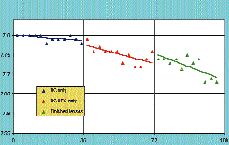
BASE CURVE VS. DIAMOND CUT # (B-31)
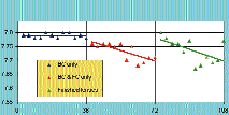
FIG. 8
BASE CURVE VS. DIAMOND CUT # (EX-120)
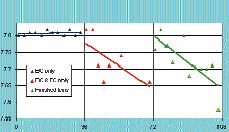
RESULTS
Assessing surface quality and diamond wear using profilometry
Delta-q is a measure of minute variations in the slope of the posterior lens surface plotted against the number of cuts made by the base curve finishing diamond. As surface quality deteriorates with increased diamond use, the delta-q and other measures of surface roughness rise. Figure 1 illustrates that the B-31 material exhibits a rapid rise in delta-q even during the earliest cuts, suggesting a need for increased polishing during finishing to yield an acceptable surface appearance. The EX-120 material shows little or no deterioration of its surface quality with diamond use. The F-30 exhibits little surface deterioration early on, but shows a reduction in surface quality when the diamond has sustained 100 or more uses. It's important for contact lens manufacturers to change diamonds before the need for increased polishing sets in.
To determine differences in the sensitivity of the materials to minor changes in diamond geometry, we cut all three surfaces with a lesser quality diamond and measured the resultant surfaces by Talysurf (Fig. 2). The EX-120 material exhibited a superior surface in the face of this challenge. The F-30 and B-31 materials were both sensitive to deteriorating geometry, exhibiting an equally poor surface quality when the diamond is severely compromised.
Subjective Surface Quality
The results of the base curve surface evaluation are shown in Figures 3, 4 and 5. Keep in mind that lower values are preferred in the grading scheme. For parts 1-12, which have base curve only, the optics values reflect the Talysurf results. Both the EX-120 and the F-30 are superior. For parts 13-24, the B-31 material improved relative to the others, probably due to exposure to hot pitch and removal of loosely attached debris in the deblocking process.
For parts 25-36, which were polished 10 seconds, the F-30 achieved the most consistently superior surfaces, followed closely by the B-31. Therefore, the EX-120 did not respond to polishing as well as the other materials with respect to subjective surface quality. It should be noted that the opportunity to minimize polishing is evident in the lower Dk materials.
Measuring Stability During Processing
We tracked the course of radius change in each set of 36 sequential base curves. We used parts 1-12 (the base curve buttons) as controls for parts 13-36. Remember that for lenses 13-24 and lenses 25-36, the center thicknesses progressively decrease from the first three lenses to the last three lenses in each set of 12.
Figures 6,7 and 8 represent the results of base curve measurement made on all 36 parts. Processing beyond base curve introduces the potential for geometry changes. From left to right, three trend lines are shown. The center of each subsequent trend line is an estimate of the average base curve, which can be used to estimate the magnitude of base curve change from the preceding group of 12 bases of that material type. The scatter of points about the trend lines is a measure of consistency, and the slope of each trend line is a measure of suitability for use in thin lens designs. The greater the slope, the lesser the suitability.
| ||||||||||||||||||||||||||||||||||||
The EX-120 material is obviously unreliable under the conditions employed. Both the F-30 and the B-31 are reasonably stable through cleaning. However, after polishing and hydration (parts 24-36 only), the B-31 exhibits greater scatter and slope, suggesting lesser utility in thin design and possibly more residual stress.
To determine the effects of hydration and polishing on the finished lenses, we compared the second and third trend lines for each material. Four of 12 lenses in the B-31 material exhibited a residual change greater than 0.02mm in radius, the maximum change still considered acceptable at this step. All of these were in the thinner lenses. For the F-30 material, one lens failed to meet the *standard for residual stability. For the EX-120 material, six lenses fell outside the 0.02mm tolerance. It is assumed that the hydration effects are the result of permanent release of internal stress.
Subjective Optical Quality
After all conditioning treatments, we inspected parts 24-36 of each material for optical quality (Fig. 9). There is an advantage with the use of the F-30 lenses as might be expected from the other findings, irrespective of thickness.
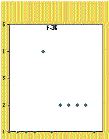
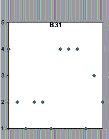

IMPACT OF SUPERIOR MACHINABILITY
The criteria we used in this study enabled us to distinguish manufacturing superiority in several key processing features. This distinction appears to be sensitive enough to allow us to distinguish differences even among materials similar in Dk and other intrinsic polymer properties. Table 1 summarizes the relative performance of the materials we tested according to our manufacturability criteria.
Material selection may play a significant role in the clinical performance of RGP contact lenses beyond the issues of Dk and wettability. Choosing a material that exhibits superior machinability, and matching that material to an optimum process may mean the difference between an adequate fit and a superior one, especially if achieving an adequate fit requires a challenging contact lens design such as unusual thinness or complicated geometry. This is particularly true when superior lathing techniques are used, providing the opportunity to minimize polishing. CLS
William Meyers is vice president, science and technology for Paragon Vision Sciences, Mesa, Ariz.



